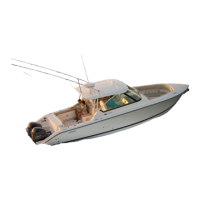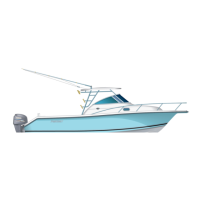Do you have a question about the PURSUIT 3000 EXPRESS and is the answer not in the manual?
Defines DANGER, WARNING, CAUTION symbols used in the manual.
Explains directional terms (bow, stern, port, starboard) and notes glossary inclusion.
Highlights risks of fuel and fire, stressing user precaution and maintenance.
Details limited warranty, registration cards, and owner's responsibilities.
Notes commitment to improvement and right to change specs without notice.
Outlines the procedure and conditions for transferring the boat's warranty.
Details warranty repair procedures, dealer contact, and owner responsibility.
Details federal and state requirements for boat registration and numbering.
Emphasizes owner's legal responsibility and need for adequate insurance coverage.
Specifies procedures for reporting boating accidents and timelines.
Recommends boating safety courses for operators and passengers.
Covers USCG and local regulations for required boat equipment.
Introduces the propulsion system and importance of engine manuals.
Details inboard drive systems, transmissions, and reduction gearing.
Outlines the engine exhaust system and its components.
Describes the engine cooling system, water intake, and sea strainers.
Covers propeller installation, proper fit, and potential issues.
Explains shaft logs, dripless seals, and struts for running gear.
Details engine gauges (tachometer, speedometer, temp, oil pressure, fuel) and alarms.
Introduces helm control systems: throttle, steering, and trim tabs.
Describes binnacle-style throttle and shift controls and their operation.
Details the function and operation of an optional engine synchronizer.
Describes the neutral safety switch function and periodic testing procedure.
Details the hydraulic steering system, its components, and operation.
Covers trim tab operation, switch use, and attitude adjustment.
Outlines maintenance for control systems, steering, and rudder ports.
General overview of the fuel system, its design, and user responsibility for maintenance.
Describes the gasoline fuel system, tanks, valves, and filters.
Explains the diesel fuel system, filters, and potential contamination issues.
Outlines safe fueling procedures and precautions at the marina.
Details maintenance for fuel lines, fill caps, filters, and fuel degradation.
Introduces the 110-volt AC and 12-volt DC electrical systems and battery types.
Explains the 12-volt system, battery configuration, and accessory distribution.
Covers the 110-volt AC system, shore power connection, and safety precautions.
Provides guidance on maintaining the 12-volt DC and 110-volt AC electrical systems.
Introduces the fresh water system components and operation.
Details how to fill, prime, and operate the fresh water system.
Describes the water heater, its heating sources, and safety.
Covers the optional shore water connection and its components.
Explains how to use the shower and the function of the shower sump pump.
Outlines routine maintenance for the fresh water system components.
Introduces raw water systems, pumps, and priming.
Details the high-pressure washdown system, pump, and connector.
Describes the livewell system, its pump, and operation.
Covers the air conditioner's raw water supply pump and its operation.
Outlines routine maintenance for the raw water system components.
Explains how water drains overboard via thru-hull fittings and valve checks.
Describes the cockpit scupper drains and water channeling.
Explains drain holes in hardtop and radar arch legs.
Details bilge pump activation (manual/auto) and location.
Describes drainage for fishboxes and storage compartments via gravity or macerator.
Explains how sinks and livewells drain via gravity to thru-hulls.
Describes drainage for showers and cabin sinks via sump pump systems.
Explains rope locker drainage via a fitting in the hull side.
Outlines routine maintenance for cockpit drains, leg drains, and bilge pumps.
Explains cabin ventilation via deck hatches and port windows.
Details the opening vent panels on the windshield.
Covers carbon monoxide hazards and the importance of proper boat ventilation.
Explains engine compartment ventilation systems (free air and forced).
Outlines maintenance for hinges, latches, acrylic glass, and ventilation ducts.
Introduces safety equipment and compliance with regulations.
Details engine alarms for temperature, oil pressure, and fuel filters.
Re-explains the neutral safety switch in the context of safety equipment.
Lists required safety equipment like PFDs, visual distress signals, and sound devices.
Explains the optional automatic fire extinguishing system and its operation.
Details the carbon monoxide monitor installation and function.
Emphasizes operator responsibility for first aid and recommends a marine first-aid kit.
Suggests additional safety equipment like EPIRBs and other considerations.
Covers general operation, safety, passenger seating, and weight distribution.
Outlines basic navigation rules for safe boating operation.
Lists essential pre-cruise checks for safety and readiness.
Provides instructions for operating the boat, including starting engines and checks.
Covers procedures and precautions for grounding and towing disabled vessels.
Addresses safety considerations during fishing operations, especially in towers.
Details operation and safety precautions for boats equipped with towers.
Advises on professional transport and trailer support for the boat.
Details deck hardware, cleats, bow pulpit, and anchor locker.
Discusses hull features like windshields and optional swim platforms.
Describes cockpit features including engine access, storage, and tackle lockers.
Describes the head compartment, marine toilet system, and holding tank.
Covers the galley equipment, sink, and stove.
Explains the convertible dinette and table for creating a berth.
Describes the optional air conditioning unit and its operation.
Describes the V-berth area, storage, and lighting.
Covers hull cleaning, bottom painting, and zinc anode maintenance.
Details cleaning and maintenance for vinyl upholstery and canvas enclosures.
Covers cleaning the cabin interior, teak, carpet, and preventing mildew.
Discusses bilge cleaning, engine maintenance, and fuel system care.
Outlines periodic maintenance for cockpit drains, leg drains, and bilge pumps.
Details steps for lay-up and storage, including fuel tanks and systems.
Covers winterizing procedures for freshwater, raw water, and marine toilet systems.
Outlines recommissioning steps after storage, including checks and engine startup.
Provides the wiring schematic for the 12-volt DC electrical system.
Presents the wiring schematic for the 110-volt AC electrical system.
Illustrates the battery cable connections and distribution.
Shows the layout of the hydraulic steering system.
Depicts the gasoline fuel system, including tanks and filters.
Illustrates the diesel fuel system components.
Shows the fresh water system layout and components.
Illustrates the bridge deck raw water system.
Depicts the plumbing for the head and holding tank system.
Illustrates the running gear components like shafts, rudders, and propellers.
Shows the shaft seal assembly and its components.
Provides a schematic of the boat's drainage system.
Illustrates the drainage system for the bridge deck.
Shows the plumbing for the bridge deck.
Illustrates the correct sling positions for lifting the boat.
Depicts the exhaust system for gasoline engines.
Illustrates the exhaust system for diesel engines.

